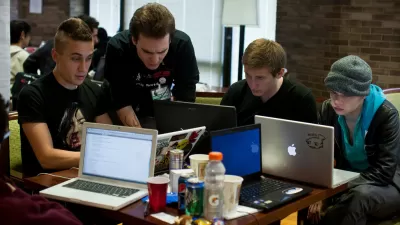As Director of Public Policy at Airbnb, Molly Turner has noticed she's the only planner in attendance at the Bay Area's myriad hackathons and conferences. As tech increasingly addresses urban issues, is it doomed to repeat planning's past mistakes?

"Here in urban Silicon Valley — and especially in San Francisco — the tech community has begun wading into the realm of urban planning, oftentimes without even realizing it," says Turner. "As an urban planner moonlighting in tech, I’ve been invited to hackathons and conferences,TEDx talks and prototyping festivals — all focused on critical urban issues ranging from homelessness to economic development, public art to public transportation. Through all of these events I’ve noticed one commonality: I’m the only urban planner there."
Why is this a problem? "[T]ech innovators also like to work on a tavola raza, void of constraints, preconceived obstacles or even the benefit of institutional knowledge," she explains. "And while sometimes that leads to genius strokes of ingenuity, other times it means unknowingly repeating mistakes of our urbanist past, such as becoming overly reliant on the wisdom of the crowd or failing to account for important social or cultural divides."
"That is precisely why tech innovators and planners have much to learn from each other. Technological solutions should better account for the complexities of urban ecosystems, and planning solutions should better pace themselves for incremental implementation."
FULL STORY: Letter from San Francisco: On Being an Urban Planner in the Tech World

Manufactured Crisis: Losing the Nation’s Largest Source of Unsubsidized Affordable Housing
Manufactured housing communities have long been an affordable housing option for millions of people living in the U.S., but that affordability is disappearing rapidly. How did we get here?

Americans May Be Stuck — But Why?
Americans are moving a lot less than they once did, and that is a problem. While Yoni Applebaum, in his highly-publicized article Stuck, gets the reasons badly wrong, it's still important to ask: why are we moving so much less than before?

Research Shows More Roads = More Driving
A national study shows, once again, that increasing road supply induces additional vehicle travel, particularly over the long run.

Judge Halts Enforcement of Anti-Homeless Laws in Grants Pass
The Oregon city will be barred from enforcing two ordinances that prosecute unhoused residents until it increases capacity and accessibility at designated camping sites.

Advancing Sustainability in Los Angeles County Schools
The Los Angeles County Office of Education’s Green Schools Symposium brings together educators, students, and experts to advance sustainability in schools through innovative design, climate resilience strategies, and collaborative learning.

Using Old Oil and Gas Wells for Green Energy Storage
Penn State researchers have found that repurposing abandoned oil and gas wells for geothermal-assisted compressed-air energy storage can boost efficiency, reduce environmental risks, and support clean energy and job transitions.
Urban Design for Planners 1: Software Tools
This six-course series explores essential urban design concepts using open source software and equips planners with the tools they need to participate fully in the urban design process.
Planning for Universal Design
Learn the tools for implementing Universal Design in planning regulations.
City of Moreno Valley
Institute for Housing and Urban Development Studies (IHS)
City of Grandview
Harvard GSD Executive Education
NYU Wagner Graduate School of Public Service
City of Cambridge, Maryland
Newport County Development Council: Connect Greater Newport





























